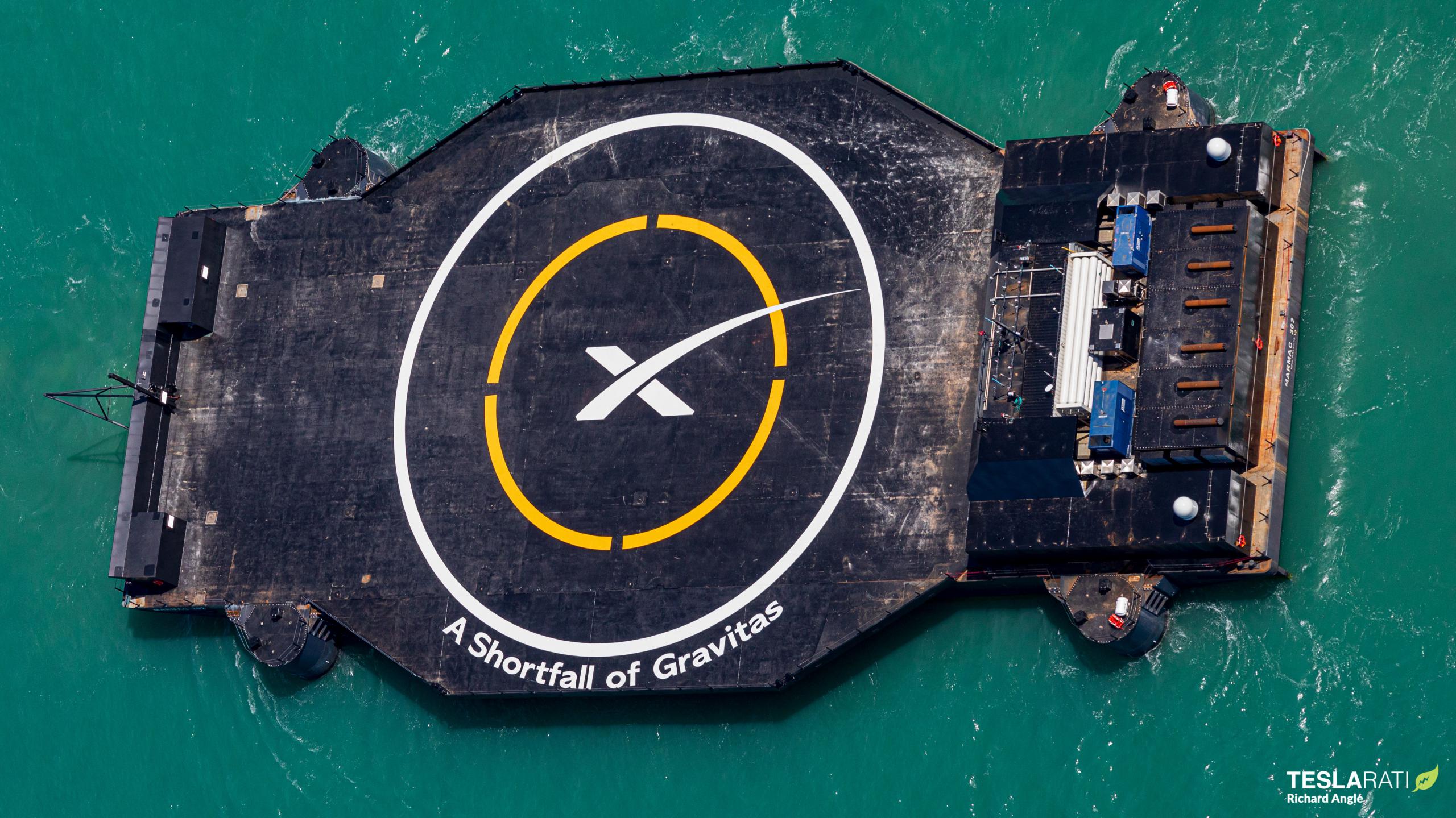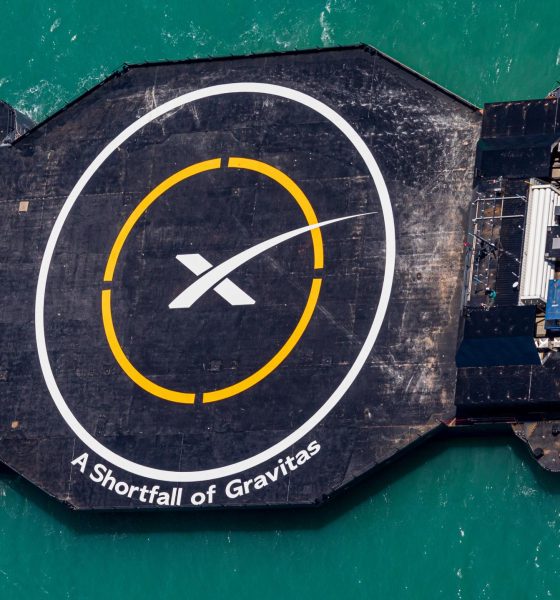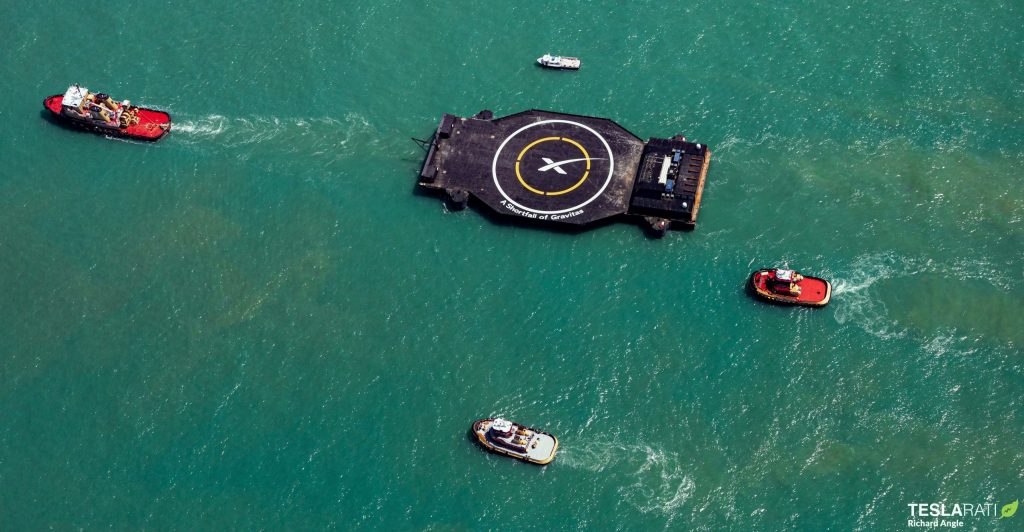

News
SpaceX’s first “Version 3” drone ship arrives at Port Canaveral
SpaceX has officially taken delivery of a third ‘autonomous spaceport drone ship’ named A Shortfall of Gravitas (ASOG), returning its East Coast booster recovery fleet to two strong.
Five weeks prior, senior drone ship Of Course I Still Love You (OCISLY) began a more than 8000 km (~5000 mi) journey from Port Canaveral, Florida to Port of Long Beach, California as part of SpaceX’s plans to return its West Coast launch facilities to active duty. Though it now appears that plans to begin the first dedicated polar Starlink launches out of Vandenberg Air Force Base (VAFB) as soon as July have slipped to no earlier than (NET) August, drone ship OCISLY did arrive at its new Los Angeles home port on July 6th, completing a smooth four-week journey.
Nine days later, brand new drone ship ASOG has completed its own slightly ambitious journey from Louisiana to the East Coast of Central Florida, allowing SpaceX to begin preparing the vessel for its first Falcon booster landing.
As previously discussed on Teslarati, A Shortfall of Gravitas marks a significant visual departure from its siblings thanks to a number of apparent refinements and upgrades.
“Drone ship ASOG appears to be a fair bit sleeker and more optimized than its siblings. The substantial amount of extra equipment required to turn a barge into a ‘drone ship’ has been packaged in a far sturdier manner inside steel bunkers, whereas JRTI and OCISLY have generators, power supplies, computers, and communications equipment strewn about the edges of their decks in shipping containers.”
According to CEO Elon Musk, ASOG may also be SpaceX’s first truly autonomous drone ship.
“Musk says that ASOG is SpaceX’s first truly autonomous drone ship. While JRTI and OCISLY are both capable of autonomously staying in one specific location after being towed out to sea and prepared by a team of technicians, ASOG may be able to travel several hundred miles out to sea, recover and secure a Falcon booster with its Octagrabber robot, and then return to Port Canaveral to offload the rocket without a single person boarding the drone ship.”
Teslarati.com – July 12th, 2021
In footage shared by Musk of ASOG’s first sea trials, the drone ship was shown traveling at a significant clip under its own power – a first for a SpaceX drone ship. While Just Read The Instructions was technically upgraded with similarly capable thrusters and power generation capabilities in 2020, the drone ship has never been seen traveling at speed under its own power during early sea trials or operational booster recoveries.


According to Elon Musk, A Shortfall of Gravitas is apparently SpaceX’s first “Version 3” drone ship, likely implying that versions 1 and 2 are respectively represented by OCISLY and JRTI. As such, while the second iteration of JRTI may technically share some of ASOG’s upgrades, it’s possible that new design choices mean that ASOG really is the first drone ship truly capable of autonomous operations. On the other hand, it’s also possible that drone ship JRTI has been capable of similar self-propelled feats since its June 2020 East Coast debut but that regulatory hurdles and complexities have prevented SpaceX from doing so.
Regardless, it’s safe to assume that SpaceX is a ways away from truly hands-free Falcon booster recoveries and that drone ship ASOG will be towed to and from landing zones – and accompanied by humans – on its first few missions.
Meanwhile, ASOG’s new ‘Octagrabber’ robot – used to remotely secure Falcon boosters at sea – has been staged on the dockside for imminent installation on the drone ship. As of mid-July, though, it’s unclear if SpaceX has any launches at all scheduled in the second half of the month, likely giving the company’s recovery team at least two weeks to prepare A Shortfall of Gravitas for its first booster recovery attempt – a rather literal baptism by fire.

News
Tesla starts showing how FSD will change lives in Europe
Local officials tested the system on narrow country roads and were impressed by FSD’s smooth, human-like driving, with some calling the service a game-changer for everyday life in areas that are far from urban centers.

Tesla has launched Europe’s first public shuttle service using Full Self-Driving (Supervised) in the rural Eifelkreis Bitburg-Prüm region of Germany, demonstrating how the technology can restore independence and mobility for people who struggle with limited transport options.
Local officials tested the system on narrow country roads and were impressed by FSD’s smooth, human-like driving, with some calling the service a game-changer for everyday life in areas that are far from urban centers.
Officials see real impact on rural residents
Arzfeld Mayor Johannes Kuhl and District Administrator Andreas Kruppert personally tested the Tesla shuttle service. This allowed them to see just how well FSD navigated winding lanes and rural roads confidently. Kruppert said, “Autonomous driving sounds like science fiction to many, but we simply see here that it works totally well in rural regions too.” Kuhl, for his part, also noted that FSD “feels like a very experienced driver.”
The pilot complements the area’s “Citizen Bus” program, which provides on-demand rides for elderly residents who can no longer drive themselves. Tesla Europe shared a video of a demonstration of the service, highlighting how FSD gives people their freedom back, even in places where public transport is not as prevalent.
What the Ministry for Economic Affairs and Transport says
Rhineland-Palatinate’s Minister Daniela Schmitt supported the project, praising the collaboration that made this “first of its kind in Europe” possible. As per the ministry, the rural rollout for the service shows FSD’s potential beyond major cities, and it delivers tangible benefits like grocery runs, doctor visits, and social connections for isolated residents.
“Reliable and flexible mobility is especially vital in rural areas. With the launch of a shuttle service using self-driving vehicles (FSD supervised) by Tesla in the Eifelkreis Bitburg-Prüm, an innovative pilot project is now getting underway that complements local community bus services. It is the first project of its kind in Europe.
“The result is a real gain for rural mobility: greater accessibility, more flexibility and tangible benefits for everyday life. A strong signal for innovation, cooperation and future-oriented mobility beyond urban centers,” the ministry wrote in a LinkedIn post.
News
Tesla China quietly posts Robotaxi-related job listing
Tesla China is currently seeking a Low Voltage Electrical Engineer to work on circuit board design for the company’s autonomous vehicles.

Tesla has posted a new job listing in Shanghai explicitly tied to its Robotaxi program, fueling speculation that the company is preparing to launch its dedicated autonomous ride-hailing service in China.
As noted in the listing, Tesla China is currently seeking a Low Voltage Electrical Engineer to work on circuit board design for the company’s autonomous vehicles.
Robotaxi-specific role
The listing, which was shared on social media platform X by industry watcher @tslaming, suggested that Tesla China is looking to fill the role urgently. The job listing itself specifically mentions that the person hired for the role will be working on the Low Voltage Hardware team, which would design the circuit boards that would serve as the nervous system of the Robotaxi.
Key tasks for the role, as indicated in the job listing, include collaboration with PCB layout, firmware, mechanical, program management, and validation teams, among other responsibilities. The role is based in Shanghai.
China Robotaxi launch
China represents a massive potential market for robotaxis, with its dense urban centers and supportive policies in select cities. Tesla has limited permission to roll out FSD in the country, though despite this, its vehicles have been hailed as among the best in the market when it comes to autonomous features. So far, at least, it appears that China supports Tesla’s FSD and Robotaxi rollout.
This was hinted at in November, when Tesla brought the Cybercab to the 8th China International Import Expo (CIIE) in Shanghai, marking the first time that the autonomous two-seater was brought to the Asia-Pacific region. The vehicle, despite not having a release date in China, received a significant amount of interest among the event’s attendees.
Elon Musk
Elon Musk and Tesla AI Director share insights after empty driver seat Robotaxi rides
The executives’ unoccupied tests hint at the rapid progress of Tesla’s unsupervised Robotaxi efforts.

Tesla CEO Elon Musk and AI Director Ashok Elluswamy celebrated Christmas Eve by sharing personal experiences with Robotaxi vehicles that had no safety monitor or occupant in the driver’s seat. Musk described the system’s “perfect driving” around Austin, while Elluswamy posted video from the back seat, calling it “an amazing experience.”
The executives’ unoccupied tests hint at the rapid progress of Tesla’s unsupervised Robotaxi efforts.
Elon and Ashok’s firsthand Robotaxi insights
Prior to Musk and the Tesla AI Director’s posts, sightings of unmanned Teslas navigating public roads were widely shared on social media. One such vehicle was spotted in Austin, Texas, which Elon Musk acknowleged by stating that “Testing is underway with no occupants in the car.”
Based on his Christmas Eve post, Musk seemed to have tested an unmanned Tesla himself. “A Tesla with no safety monitor in the car and me sitting in the passenger seat took me all around Austin on Sunday with perfect driving,” Musk wrote in his post.
Elluswamy responded with a 2-minute video showing himself in the rear of an unmanned Tesla. The video featured the vehicle’s empty front seats, as well as its smooth handling through real-world traffic. He captioned his video with the words, “It’s an amazing experience!”
Towards Unsupervised operations
During an xAI Hackathon earlier this month, Elon Musk mentioned that Tesla owed be removing Safety Monitors from its Robotaxis in Austin in just three weeks. “Unsupervised is pretty much solved at this point. So there will be Tesla Robotaxis operating in Austin with no one in them. Not even anyone in the passenger seat in about three weeks,” he said. Musk echoed similar estimates at the 2025 Annual Shareholder Meeting and the Q3 2025 earnings call.
Considering the insights that were posted Musk and Elluswamy, it does appear that Tesla is working hard towards operating its Robotaxis with no safety monitors. This is quite impressive considering that the service was launched just earlier this year.








